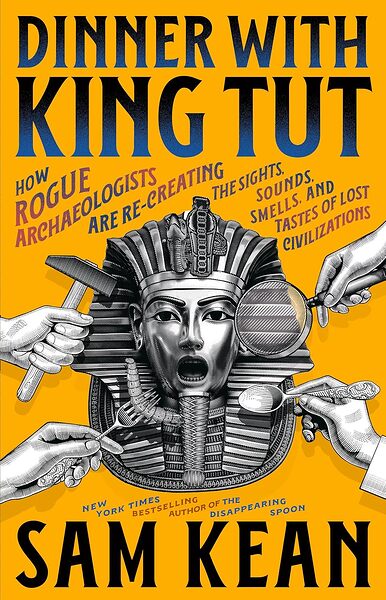Looking for a good read? Here is a recommendation. I have an unusual approach to reviewing books. I review books I feel merit a review. Each review is an opportunity to recommend a book. If I do not think a book is worth reading, I find another book to review. You do not have to agree with everything every author has written (I do not), but the fiction I review is entertaining (and often thought-provoking) and the non-fiction contain ideas worth reading.
Book Review
Hearing, Smelling and Tasting the Past
Reviewed by Mark Lardas
July 20, 2025
“Dinner with King Tut: How Rogue Archaeologists Are Re-creating the Sights, Sounds, Smells, and Tastes of Lost Civilizations,” by Sam Kean, Little, Brown and Company, July 2025, 464 pages, $32.50 (Hardcover), $16.99 (E-book), $28.79 (Audiobook)
Archaeology has been a serious science for 150 years. Over that period scientists have discovered how people lived in bygone eras. At one level, modern archaeology involves tedium, a slow patient unravelling of clues to the past. Some archaeologists want to go beyond just learning about the past. They itch to experience the past they are studying.
“Dinner with King Tut: How Rogue Archaeologists Are Re-creating the Sights, Sounds, Smells, and Tastes of Lost Civilizations,” by Sam Kean, scratches that itch. It explores experimental archeology, archeology investigating the past by experiencing it.
Experimental archaeology is sometimes called experiential or living archeology. It goes beyond the static sights of standard archaeology. It examines smells, tastes, and sounds of the past. It recreates the past in the present using era-appropriate technology of the. Participants dress deer hides, prepare food, brew beer, and live using traditional methods. As Kean shows, it is a bit of a rogue field, gonzo archaeology, looked down upon by many traditional archaeologists.
Kean is fascinated by it. In this book he takes readers with him into eleven different periods of the past, from Paleolithic Africa, circa 75,000 BC to 16th century Mexico in the age of the Aztecs and Conquistadors. In between these bookends, Kean visits Neolithic South America and Turkey, ancient Egypt, Polynesia, and Rome, and Medieval California, Viking Europe, Alaska, and China. At each stop he explores the civilization visited.
Each chapter exploring the lives of those living in that time and place with non-fiction. This includes a discussion of what conventional archaeology has uncovered mixed with experimental archaeology of each place. The experimental archaeological excursions are varied. They include making a Paleolithic dust bed, making (and eating) bread using ancient Egyptian techniques, learning how to raise blocks to build an Egyptian pyramid, firing Medieval trebuchets and cannon, and playing an Aztec ball game.
He intersperses each chapter with a fiction retelling of life in the period, using an inhabitant for the point of view. This character might be a hunter, a farmer, a slave, a craftsperson, or a warrior of the era. The fictionalized retelling parallels the non-fiction discussion, reinforcing the points made.
“Dinner with King Tut” is both informative and entertaining. Kean brings each place visited to life. His enthusiasm is clear as he participates in each experimental archeological activity. This is a book for anyone with a bit of Walter Mitty inside them.
Mark Lardas, an engineer, freelance writer, historian, and model-maker, lives in League City. His website is marklardas.com.
